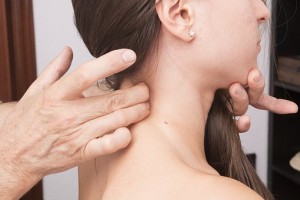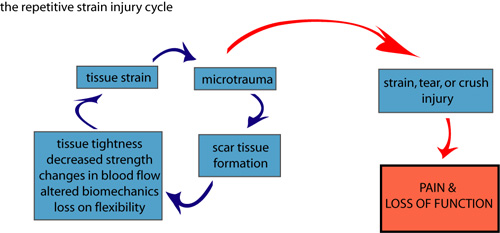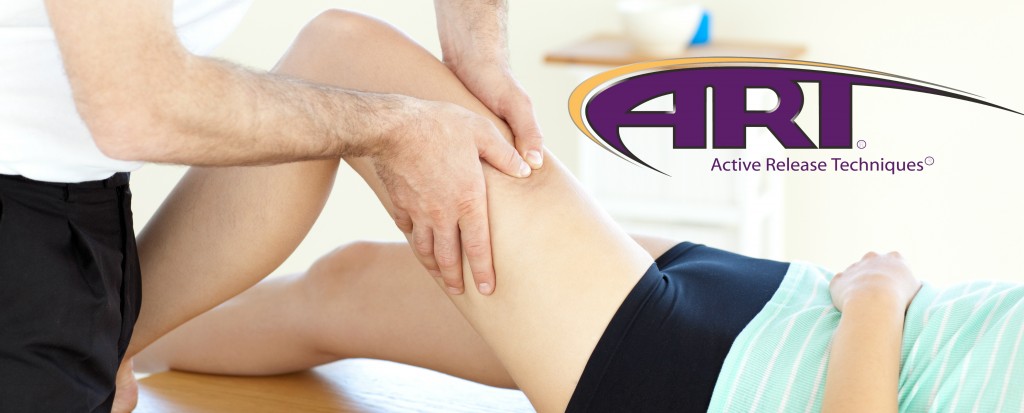Resolving Neck Pain with Active Release Techniques®
If you experience neck pain you are not alone. Neck pain is quickly becoming one of the most common reasons for visiting the doctor’s office. Anyone who suffers with neck pain knows that the condition can dramatically interfere with our daily lives, often making driving, sleeping, exercising, and even concentrating very difficult. As if that wasn’t enough, neck pain is often recurrent, with the same problem occurring over and over again. To make matters worse, many common neck conditions are often slow to respond to traditional types of care, often providing only temporary relief.
Now for the good news, a new treatment technique known as Active Release Techniques® (ART®) is proving to be a very effective method to treat many common neck problems and is helping to get neck pain sufferers back doing their favourite activities. But before we talk about how ART® works so effectively we first need to understand how the neck becomes injured in the first place.
Do you ever have neck pain or headaches? Did you know that many headaches are caused by the nerves in the neck and other neck related injuries and problems? In this video, Dr. Barbara Rodwin (DC) explains this, and demonstrates how to relieve both headaches and neck pain/problems using an Acuball. Dr. Rodwin would be happy to answer any questions you may have about this by email: dr.rodwin@back2health4you.com
Understanding Neck Pain
When talking about the neck, we are actually talking about the upper portion of the spinal column – the cervical spine. The cervical spine consists of 7 small bones called “vertebrae” stacked on top of each other, each of which is connected through a series of joints. These joints allow the neck to turn and bend, which is important for all of our everyday movements. By themselves the joints of the cervical spine are not very stable, so to protect the region, a complex system of muscles surrounds the spinal column to control movement and protect the area from injury. These muscles are arranged in several layers. The deepest layers consist of very small muscles that attach into each individual vertebrae and control and protect each individual joint. The middle layers span across several joints, and the outer layer consists of the larger, more powerful muscles that run the entire length of the neck, all the way from head to the shoulders.

Not only do these muscles need to move and protect the cervical spine, but they also must control the weight of the head. The head and neck have a unique anatomical relationship in that the larger, heavier head – which weighs about 10 pounds – sits atop the thinner neck. This essentially represents an inverted pendulum where the natural tendency is for the heavier head, which represents the top of the inverted pendulum, to topple over. This places a high demand on the neck muscles to both support and control the weight of the head, while at the same time ensuring adequate movement and stability of the joints of the cervical spine. This complex process requires each muscle to be adequately strong, flexible, and coordinated. In this state, the neck remains protected and healthy, and will not generate headache symptoms.
How Does Injury Occur?
The health of the neck depends on a complex interaction of muscular contractions to move and stabilize each joint in our cervical spine, and properly move and position the head. If any of the muscles that surround the cervical spine become tight, weak, or uncoordinated, this will place excessive strain on the other surrounding muscles and on the spinal column itself. Over time, if imbalance in the muscles and resulting abnormal head and neck motion is allowed to continue it can eventually develop in more severe neck conditions.
There are a variety of situations that can cause tightness, weakness, and abnormal function of the neck muscles. For example, poor or prolonged postural strain that occurs with computer use and desk jobs, repetitive use with certain sports, muscle imbalances, lack of stretching or strengthening, or previous injury such as car accidents (even minor accidents with little or no injuries that occurred at the time). These can all affect the normal function of the neck and surrounding muscles resulting in excessive strain to the area.

Over time this strain can develop into what is know as micro-trauma. Simply stated, micro-trauma is very small scale damage that occurs in the muscles, tendons, joint capsules, and ligaments in response to small levels of strain. Initially micro-trauma is not painful, but may be perceived as a mild ache or tightness in the muscles. Although only small, this damage still needs to be repaired. The body responds to micro-trauma in a predictable way – by laying down small amounts of scar tissue to repair the area.
Unfortunately, over time scar tissue will build-up and accumulate into what we call adhesions. As these adhesions start to form they start to affect the normal health and function of the muscles and related joints. In fact, they will often lead to pain, tightness, stiffness, restricted joint motion, and diminished blood flow. This places even further strain on the neck muscles, which in turn leads to even more micro-trauma. Essentially a repetitive strain injury cycle is set-up causing continued adhesion formation and progressive cervical spine dysfunction. At this point pain and tightness will often start to become noticeable.
Neck Pain and the Kinetic Chain Relationship
When discussing any type of neck problem we also need to review the relationship that the cervical spine has with the other joints in the body, particularly the shoulder region.
The shoulder is an extremely mobile area that allows us to reach up over head, push, pull, and carry. To accomplish these motions the shoulder also has a complex system of muscles to protect and stabilize the region. It is very common for muscle tightness and abnormal movement to develop in the shoulder and shoulder blade. Even in cases where there no specific symptoms in the shoulder itself, any amount of shoulder dysfunction can have a tremendous impact on the neck. This occurs because many shoulder muscles, particularly the muscles of the shoulder blade, actually attach onto the joints of the neck and onto the back of the head. When these muscles become tight it will it turn compromise the normal health and movement of the neck, leading to neck pain. We have found that in many neck conditions, in addition to treating the neck itself, correcting the tightness and dysfunction in the shoulder muscles is also required for a permanent solution.
How Can These Neck Injuries Be Fixed?
The Traditional Approach…
In an attempt to relieve neck pain, a variety of treatment methods are used, either on their own, or in combination with other methods. Some of the more common approaches include muscle relaxants, anti-inflammatory medications, rest, heat, ice, ultrasound (US), muscle stimulation (E-Stim), massage, acupuncture, stretching and strengthening exercises, and when all else fails, surgery. Unfortunately, most of these traditional techniques generally require a long period of time before they provide any significant relief, and in many cases provide only temporary relief from symptoms instead of fixing the underlying cause of the problem.
The main reason that these approaches are often ineffective is that they fail to address the underlying muscle dysfunction and scar tissue adhesions that develop within the muscles and surrounding soft tissues. It is these adhesions that are binding the tissues together, restricting normal movements, and interfering with the normal flexibility and contraction of the muscles in and around the spine.
Passive approaches such as muscle relaxants and anti-inflammatory medications, rest, ice, and ultrasound, all focus on symptomatic relief and do nothing to address the muscle restrictions and dysfunction. More active approaches such as stretching and exercises are often needed for full rehabilitation of the condition and to restore full strength and function of the muscles, however, they themselves do not treat the underlying adhesions. In fact, without first addressing the scar tissue adhesions, stretches and exercises are often less effective and much slower to produce relief or recovery from neck pain.
Active Release Techniques® Our Approach: ART® – A Better Solution
ART stands for Active Release Technique. It is a new and highly successful hands-on treatment method to address problems in the soft tissues of the body, including the muscles, ligaments, fascia, and nerves. ART* treatment is highly successful in dealing with injuries because it is specifically designed to locate and treat scar tissue adhesions that accumulate in the muscles and surrounding soft tissues. By locating and treating the soft-tissue adhesions with ART*, it allows the practitioner to:
1) break-up restrictive adhesions
2) reinstate normal tissue flexibility and movement
3) more completely restore flexibility, balance, and stability to the injured area and to the entire kinetic chain

You can think of an ART* treatment as a type of active massage. The practitioner will first shorten the muscle, tendon, or ligament, and then apply a very specific pressure with their hands as you actively stretch and lengthen the tissues. As the tissue lengthens the practitioner is able to assess the texture and tension of the muscle to determine if the tissue is healthy or contains scar tissue that needs further treatment. When scar tissue adhesions are felt the amount and direction of tension can be modified to treat the problematic area. In this sense, each treatment is also an assessment of the health of the area as we are able to feel specifically where the problem is occurring.
An additional benefit of ART is it allows us to further assess and correct problems not only at the site of pain itself, but also in other areas of the kinetic chain, which are associated with movement compensations and are often contributing factors to the problem. This ensures that all the soft tissues that have become dysfunctional and are contributing to the specific injury are addressed, even if they have not yet all developed pain.
One of the best things about ART is how fast it can get results. In our experience, the majority of injuries respond very well to ART* treatment, especially when combined with the appropriate home stretching and strengthening exercises. Although each case is unique and there are several factors that will determine the length of time required to fully resolve each condition, we usually find a significant improvement can be gained in just 4 – 6 treatments. These results are the main reason that many elite athletes and professional sports teams have ART practitioners on staff, and why ART is an integral part of the Iron man triathlon series.
To book an appointment to see if ART will be able to help with your related injury, simply call our office at 613.237.3306.


